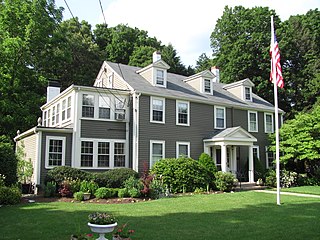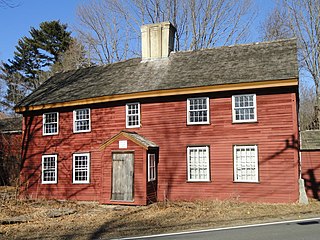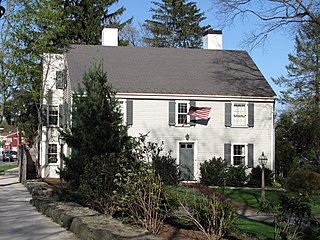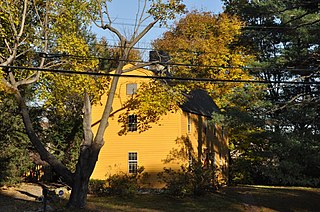
The Benjamin Adams House is a historic house located at 85 North Main Street, in Uxbridge, Massachusetts. Probably built before 1792, it is a good quality example of Federal period architecture, built for a prominent local lawyer and businessman. On October 7, 1983, it was listed on the National Register of Historic Places.

The John Ward House is a National Historic Landmark at 9 Brown Street in Salem, Massachusetts, United States. With an early construction history between 1684 and 1723, it is an excellent example of First Period architecture, and as the subject of an early 20th-century restoration by antiquarian George Francis Dow, it is an important example of the restoration techniques. Now owned by the Peabody Essex Museum, it is also one of the first colonial-era houses in the United States to be opened as a museum. It was designated a National Historic Landmark in 1968.

The Simeon Alexander Jr. House is an historic house on Millers Falls Road south of Pine Meadow Road in Northfield, Massachusetts. Built about 1780, it is one of the town's best surviving examples of an early Federal period farmhouse, built by a prosperous local farmer. The house was listed on the National Register of Historic Places in 1991.

The Caleb Cushing House and Farm is a historic farm property at 186 Pine Street in Rehoboth, Massachusetts. The farm, established about 1750, includes a pre-Revolutionary Georgian farmhouse and an 1836 Federal-Greek Revival Cape house, and was owned by the Cushing family into the mid-20th century. The property was listed on the National Register of Historic Places in 1983.

The Kingsbury-Whitaker House is a historic house in Needham, Massachusetts. The 2+1⁄2-story wood-frame house has at its core elements of a house that was built on the site in about 1720. The old house, built by Deacon Timothy Kingsbury, became the significantly-altered nucleus of a larger house built in 1840 by Edward Whitaker, a prominent local businessman. With further additions, the building encapsulates more than 200 years of construction methods. The house was listed on the National Register of Historic Places in 1990.

The Robert Fuller House is a historic house at 3 Burrill Lane in Needham, Massachusetts. Built in 1707 and moved to its present location in 1750, it is the oldest house in Needham. It is a well-preserved example of First Period architecture, adaptively modified over the centuries to adapt to later uses. The house was listed on the National Register of Historic Places in 1987.

The Benjamin Abbot House or Abbot Homestead is a historic house at 9 Andover Street in Andover, Massachusetts, USA. The house was built in 1711, and is one of the oldest in Andover. It was listed on the National Register of Historic Places in 1975.

The Abbot-Stinson House is a historic house in Andover, Massachusetts. The house is estimated to have been built in the early 1720s, in the transitional period between First Period and Georgian styles of construction. It was originally one room deep with a central chimney, but was extended by additions to the rear in the 20th century. The house was listed on the National Register of Historic Places in 1990.

The Abraham Hill House is an historic First Period house in Belmont, Massachusetts, United States. Probably built in the early 18th century, it is one of the oldest buildings in the town. Its construction history shows changing residential trends over two hundred years of history. The house was listed on the National Register of Historic Places in 1990.

The Joseph Damon House is a historic house in Reading, Massachusetts. Built about 1754, this 2+1⁄2-story wood-frame house is good local example of a Georgian colonial house with later Federal period alterations. It also demonstrates a typical pattern of shared ownership by multiple descendants of one of its owners. The house was listed on the National Register of Historic Places in 1984.

The Jonathan Fletcher House is a historic house in Medford, Massachusetts. The 2+1⁄2-story wood-frame house was built c. 1835; its builder clearly drew inspiration from designs published by Asher Benjamin, and is an excellent example of transitional Federal-Greek Revival architecture. The house was listed on the National Register of Historic Places in 1975.

The Daniel Morse III House is a historic First Period house at 210 Farm Road in Sherborn, Massachusetts. With its oldest portion dating to about 1710, it is one of the town's oldest surviving buildings. It was listed on the National Register of Historic Places in 1986.

The Capt. William Green House is a historic colonial house at 391 Vernon Street in Wakefield, Massachusetts. It is one of Wakefield's oldest surviving buildings. The house was listed on the National Register of Historic Places as part of two separate listings. In 1989 it was listed under the name "Capt. William Green House", and in 1990 it was listed under the name "Green House".

The Blake Daniels Cottage is a historic house at 111–113 Elm Street in Stoneham, Massachusetts. Built in 1860, it is a good example of a Greek Revival worker's residence, with an older wing that may have housed the manufactory of shoe lasts. The house was listed on the National Register of Historic Places in 1984.

The Manning-Ball House is a historic house at 370 Manning Street in Jefferson, a village of Holden, Massachusetts. It is estimated to have been built c. 1790, and is a well-preserved vernacular four-bay Cape style house. It was listed on the National Register of Historic Places on December 13, 1995.

The Howe-Quimby House is a historic house on Sugar Hill Road in Hopkinton, New Hampshire. Built about 1780, it is a well-preserved example of a rural 18th-century farmhouse with later stylistic modifications. The house was listed on the National Register of Historic Places in 1980.

The Henry Strongman House is a historic house at 1443 Peterborough Road in Dublin, New Hampshire. Built about 1770 by Dublin's first permanent white settler, it is a well-preserved example of a rural Cape style farmhouse. The house was listed on the National Register of Historic Places in 1983.

The William Peabody House is a historic house on North River Road in Milford, New Hampshire. This 2+1⁄2-story wood-frame house was built c. 1740 by William Peabody, the first English settler of the Milford area, and remains a good example of Georgian residential architecture despite a 1973 fire. The house was listed on the National Register of Historic Places in 1979.

The John and Ruth Rose House is a historic house at 944 Main Road in Granville, Massachusetts. It was built about 1742 by John Rose, one of the first colonial settlers of the area, and is a good example of rural Georgian architecture. The house was listed on the National Register of Historic Places in 2018.
The Fowler-Clark-Epstein Farmstead is a historic house and farm complex at 487 Norfolk Street in Boston, Massachusetts. Possibly built sometime between 1786 and 1806, the house on the property is one of the city's oldest surviving farmhouses. It was listed on the National Register of Historic Places in 2020. It is now home to the Urban Farm Institute, a local nonprofit organization.






















